Every year in our garden, peonies take us by surprise. I don’t know if they get better every year, or if I have low expectations, but they constantly seem to do better than I remember with gorgeous pink and white blooms with a truly intoxicating perfume.
Despite their reputation as complicated plants, I’ve always found peonies to be resilient and fairly low maintenance but there are some key facts that every gardener should know.
So we’ve put together a full peony grow guide and everything you need to know about the differences between tree peonies, herbaceous peonies, and the ever-perplexing intersectional peonies.
More...
Family: | Paeoniaceae |
|---|---|
Genus: | Paeonia |
Common Names: | Peony |
Location: | Outdoor |
Type: | Herbaceous perennial, or woody shrub |
Growth: | 1-3m tall |
Sun requirements: | Full sun |
Foliage Colour: | Green |
Flower Colour: | Pink, white, red, cream |
Flowering: | October-December |
Fruit: | None |
Maintenance level: | Medium |
Poisonous for pets: | Toxic to pets |
What are Peonies?
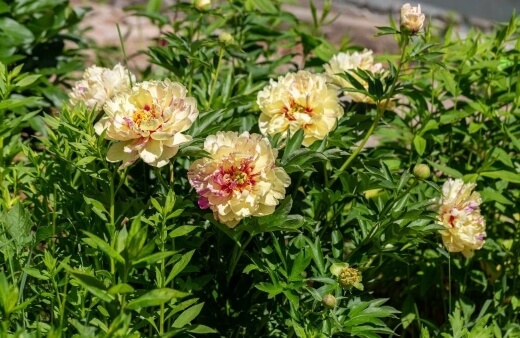
There are somewhere between 25 and 40 species of peonies in the world, but all fall into three categories; tree peonies, herbaceous peonies, and intersectional peonies. We’ll look at the difference later, but all share some similar habits.
Peonies are herbaceous or shrubby perennial plants and are hardy in most climates. Their leaves are so deeply lobed that they almost appear palmate, but are in fact a collection of oval or lanceolate leaflets connected through a shared mid-rib.
They flower from new growth every year just above the final leaf node on a stem, and flower for a relatively short window between October and December.
Peonies’ Natural Habitat
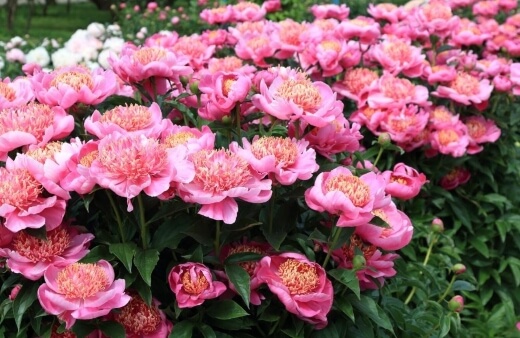
Peonies like cool climates and fertile soils but are well adapted through their own evolutions with species native to Asia, Europe, and North America, though the vast majority are native to Eastern Asia.
Due to their intense natural beauty, peonies are one of the oldest recorded garden plants, with some found in remains of Chinese gardens dating back over 3000 years
Despite being cool climate plants, peonies can be grown in every part of Australia provided they are given some shade and plenty of water in warmer states.
Different Types of Peonies
There are two ways to categorise peonies. The first is by growth habit, with every species and cultivar of peony falling into one of three categories:
- Tree Peonies
- Herbaceous Peonies
- Intersectional Peonies
The second is flower form, which is slightly more complicated and widely the product of human intervention and breeding. We’ll look at each in detail below, but the six main groups of peony flowers are:
- Single
- Semi-double
- Double
- Japanese
- Anemone
- Bombe
Peonies by Growth Habits
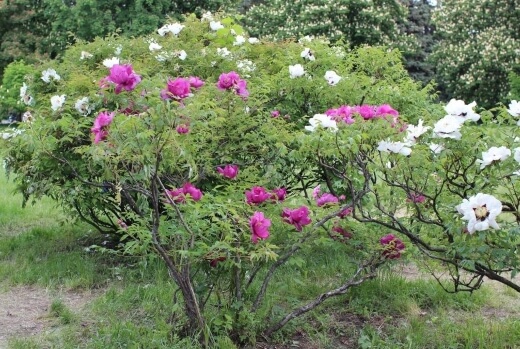
Tree Peonies
The name ‘tree peonies’ describes the structure of the plant rather than its physical appearance as they rarely reach over 1.5m tall. They grow on tough woody stems, and flower on young green shoots each year, eventually forming a dense mass of deciduous growth that adds structure to borders in winter, fragrance in summer, and ethereal foliage for the rest of the year.
Tree peonies can live for over 80 years, so are a good investment for gardeners looking to add permanent and reliable colour to a garden. Other than an annual prune and a generous spring mulch, there is very little work to do in caring for them.
Herbaceous Peonies
Herbaceous peonies are perhaps the hardest to grow. While they die back in winter, they suffer from pests and diseases and are more susceptible to root rot.
Their flowers are more varied, and usually have more fragrance than tree peonies though, so if you want the full impact of peonies these bold herbaceous perennial types are the best option.
Intersectional Peonies
Intersectional peonies (also called Itoh peonies after the Japanese plant breeder that developed them in the 1940s) are a cross between tree peonies and herbaceous peonies. They were developed to be easier to care for, but with all the impact and fragrance of herbaceous varieties.
The semi-woody stems of Itoh peonies have the strength of tree peonies without the height and can be pruned in multiple ways depending on the structure you’re after.
Peonies by Flower Forms
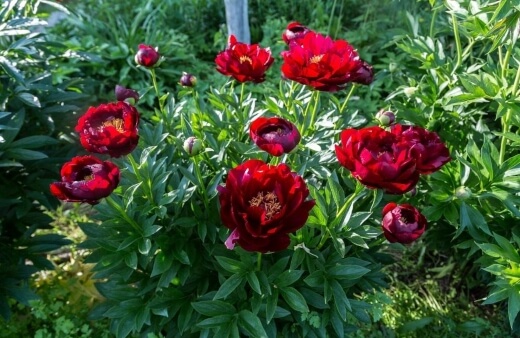
Single Peonies
Most people grow peonies for a combination of fragrance and beauty, with densely clustered pompoms of petals, but single flowers are so packed full of nectar and scent that it’s often worth forgoing the more visually impactful qualities for their fragrance alone.
If you’re developing a wildlife garden, it’s also worth noting that single peony blooms are much more beneficial to bees and pollinators than the closed cup blooms of most varieties.
Semi-double Peonies
There are three types of double peony blooms, including Lotus, Chrysanthemum, and Rose type peonies. While they still have open centres which are accessible for pollinators, they have much blousier and more dramatic flower heads.
Lotus-form peonies have darker centres, with uneven serrations on the edge of each petal, making for a lighter appearance. Chrysanthemum semi-double peonies have rounded petals that form concentric rings around the centre, much like the dense flowers they are named after.
While Rose peonies are open centres with fluffy petals packed in so tightly that it’s hard to know when one petal ends and another starts.
Double Peonies
Double peonies are incredibly beautiful flowers, with an outer layer of flat petals, often in multiple layers, with an inner section of curled petals forming a dense ball around the centre of the flower.
They are inaccessible to pollinators, but still, pump out fragrance when the flowers emerge.
Japanese Peonies
The Japanese peonies are similar to single-form peonies, with a simple ring of petals around the centre and an open form. However, their stamens and anthers are elongated, creating a fluffy dome within a cup of petals that has the charm of doubling, without affecting pollinators.
Anemone Peonies
Anemone peonies are often called double peonies, but they are more similar to Japanese peonies, with open flower heads and domed anthers.
The difference is the petal form itself, which is almost identical to Japanese anemones due to their lobed petals and rounded edges.
Bombe Peonies
Bombe peonies are such tightly packed double flowers that I find their scent suffers slightly, and they tend to struggle with fungal problems after heavy rainfall due to moisture trapped between the dense petals.
However, for most of Australia, they are well worth growing as the hotter conditions tend to reduce problems. As the buds open, they reveal balls of tightly packed, crumpled petals, which form a full ball as the base petals open and revert backward, creating a flat, or even inverted plate beneath the main structure.
10 Best Peonies to Grow in Australia
1. Paeonia suffruticosa ‘Kinshi’One of the most old-fashioned tree peonies is the Japanese variety, Kinshi. This rose form peony has one of the most delicate custard-yellow flowers, with a sweet soft fragrance. While it can grow to an ultimate height of around 1.5m, it is best pruned hard each year to create a denser flowering structure. |  |
2. Paeonia lactiflora ‘Shirley Temple’I’m not sure if a plant has ever been better matched to its name than this blousy pink, full double peony that regrows with an unrivalled vigour in spring, and dies dramatically back to the ground in autumn. The rich red stems that hold each flower help to accentuate the delicate pinks which are highlighted against the deeply coloured herbaceous foliage. | 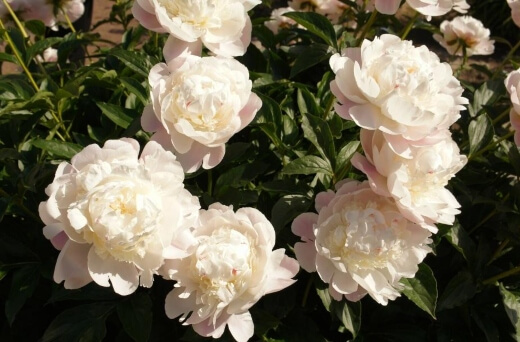 |
3. Paeonia ‘Black Panther’ (Hybrid)A hybrid between multiple lutea and suffruticosa species peonies, Black Panther has a deep, chocolatey red, coupled with a bright yellow centre that can be pruned hard in winter, or pruned more considerately in spring to form a perfect dome of grey-green foliage which is completely covered in some of the darkest peony flowers there are. | 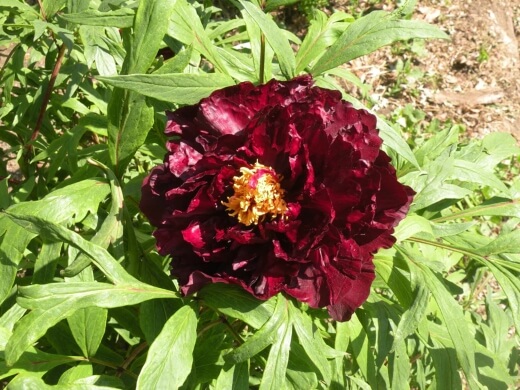 Source: treepeony.com |
4. Paeonia ‘Coral Charm’ (Hybrid)This hybridised peony might not be a pure species peony, but it’s easier to care for than the intersectional types. The coral pink blooms are held on bright green stems, with closely cupped semi-double flowers. | 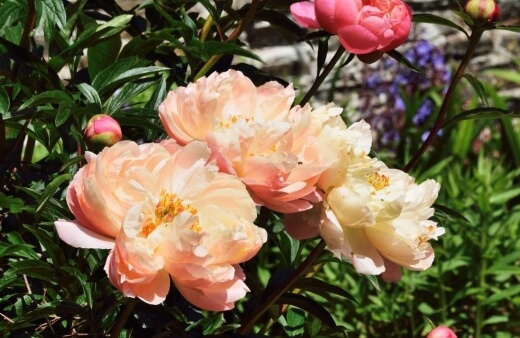 |
5. Paeonia lactiflora ‘Bowl of Beauty’These Japanese peonies have a beautiful double-layered flower with a vivid pink that acts as a base to a plume of white central petals. They are highly ornamental and incredibly easy to grow in the right conditions. | 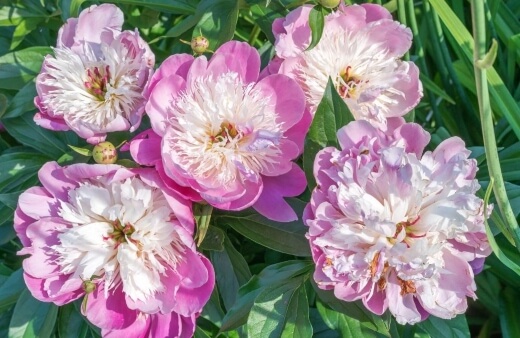 |
6. Paeonia ‘Duchess of Kent’ (Hybrid)This hybrid tree peony, Duchess of Kent, grows well in dappled shade, and can cope with most soil types so is a useful choice for warmer regions where the temperature is more of a concern. The traditional red blooms sit neatly in a tight arrangement with the deeply lobed dusty-green foliage. |  Source: gardenersworld.com |
7. Paeonia ‘Lollipop’ (Hybrid)Lollipop is probably the most excitingly patterned peony you can grow, and is one of the earliest intersectional peonies. It never has two flowers the same. However, they are typically a pale creamy-yellow colour with splashes of painterly reds and pinks firing out from the centre of each petal. The tight centres have a rigidity which helps each flower last longer too. | 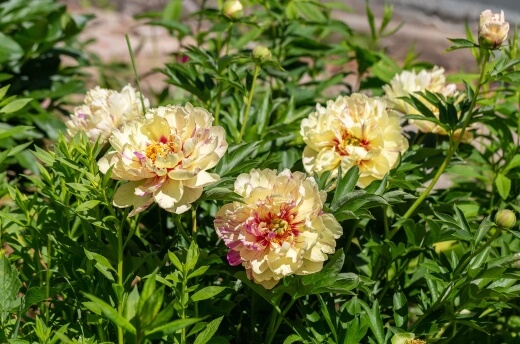 Source: farmergracy.co.uk |
8. Paeonia x lemoinei ‘Souvenir de Maxime Cornu’The peachy pink flowers of these peonies have a distinct rose flower form and develop as tall shrubs that can outgrow most peonies, reaching 2m tall if left unchecked. However, they should be pruned back regularly, and look their best at around 1-1.5m tall with a goblet structure which encourages heavier flower production. | 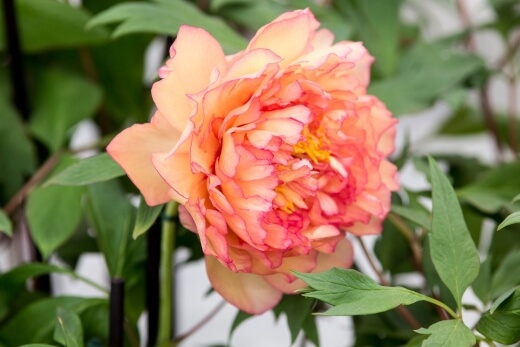 Source: gardenersworld.com |
9. Paeonia ‘Happy Days’ (Hybrid)As hybrid tree peonies go, Happy Days are perhaps one of the simplest, with an open single flower form that looks similar to a summer dog rose, and flowers later in the year (around halfway through summer). Their soft papery foliage has a delicacy that is unmatched by other cultivars and has been bred almost entirely for fragrance. |  Source: treepeony.com |
10. Paeonia suffruticosa ‘Shima Nishiki’I’m not one to give definite answers on things, and much prefer to let gardeners make up their own minds but, if you’re into flower arranging, Shima Nishika is the single best peony you can buy. Its neat cupped flowers last for over 2 weeks in a vase of sugared water, with painted white and red leaves that work with almost any arrangement as a centre or base flower. In the garden, they hold their scent right up until they need deadheading, and work in almost all locations, including dappled shade, so are ideal for any part of Australia provided you can give them reasonable drainage and plenty of food. | 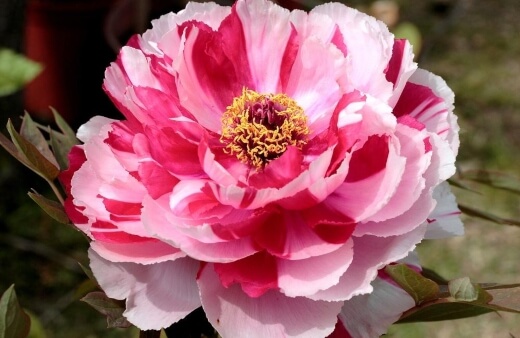 |
1. Paeonia suffruticosa ‘Kinshi’

One of the most old-fashioned tree peonies is the Japanese variety, Kinshi. This rose form peony has one of the most delicate custard-yellow flowers, with a sweet soft fragrance.
While it can grow to an ultimate height of around 1.5m, it is best pruned hard each year to create a denser flowering structure.
2. Paeonia lactiflora ‘Shirley Temple’

I’m not sure if a plant has ever been better matched to its name than this blousy pink, full double peony that regrows with an unrivalled vigour in spring, and dies dramatically back to the ground in autumn.
The rich red stems that hold each flower help to accentuate the delicate pinks which are highlighted against the deeply coloured herbaceous foliage.
3. Paeonia ‘Black Panther’ (Hybrid)

Source: treepeony.com
A hybrid between multiple lutea and suffruticosa species peonies, Black Panther has a deep, chocolatey red, coupled with a bright yellow centre that can be pruned hard in winter, or pruned more considerately in spring to form a perfect dome of grey-green foliage which is completely covered in some of the darkest peony flowers there are.
4. Paeonia ‘Coral Charm’ (Hybrid)

This hybridised peony might not be a pure species peony, but it’s easier to care for than the intersectional types. The coral pink blooms are held on bright green stems, with closely cupped semi-double flowers.
5. Paeonia lactiflora ‘Bowl of Beauty’

These Japanese peonies have a beautiful double-layered flower with a vivid pink that acts as a base to a plume of white central petals. They are highly ornamental and incredibly easy to grow in the right conditions.
6. Paeonia ‘Duchess of Kent’ (Hybrid)

Source: gardenersworld.com
This hybrid tree peony, Duchess of Kent, grows well in dappled shade, and can cope with most soil types so is a useful choice for warmer regions where the temperature is more of a concern.
The traditional red blooms sit neatly in a tight arrangement with the deeply lobed dusty-green foliage.
7. Paeonia ‘Lollipop’ (Hybrid)

Source: farmergracy.co.uk
Lollipop is probably the most excitingly patterned peony you can grow, and is one of the earliest intersectional peonies. It never has two flowers the same.
However, they are typically a pale creamy-yellow colour with splashes of painterly reds and pinks firing out from the centre of each petal. The tight centres have a rigidity which helps each flower last longer too.
8. Paeonia x lemoinei ‘Souvenir de Maxime Cornu’
The peachy pink flowers of these peonies have a distinct rose flower form and develop as tall shrubs that can outgrow most peonies, reaching 2m tall if left unchecked.
However, they should be pruned back regularly, and look their best at around 1-1.5m tall with a goblet structure which encourages heavier flower production.
9. Paeonia ‘Happy Days’ (Hybrid)

Source: treepeony.com
As hybrid tree peonies go, Happy Days are perhaps one of the simplest, with an open single flower form that looks similar to a summer dog rose, and flowers later in the year (around halfway through summer).
Their soft papery foliage has a delicacy that is unmatched by other cultivars and has been bred almost entirely for fragrance.
10. Paeonia suffruticosa ‘Shima Nishiki’

I’m not one to give definite answers on things, and much prefer to let gardeners make up their own minds but, if you’re into flower arranging, Shima Nishika is the single best peony you can buy.
Its neat cupped flowers last for over 2 weeks in a vase of sugared water, with painted white and red leaves that work with almost any arrangement as a centre or base flower.
In the garden, they hold their scent right up until they need deadheading, and work in almost all locations, including dappled shade, so are ideal for any part of Australia provided you can give them reasonable drainage and plenty of food.
How to Grow Peonies in Australia
Peonies aren’t as expensive as they once were, but can still cost over $100 for a young intersectional variety, so getting the right conditions sorted before planting is essential.
Below, we’ll look at how to prepare your ground, and care for them after planting, as well as the physical methods to give them as much support as possible during their first few years.
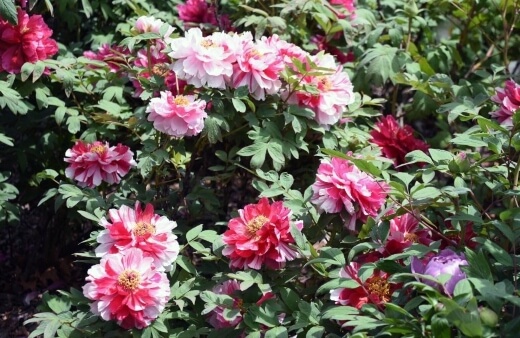
Best Conditions for Planting Peonies in Australia
Soil & Drainage
Peonies are happy in most soils provided they are well-drained and will never sit in water. All three types of peonies will rot from the root if they are left in standing water or boggy conditions for more than a couple of days.
They also need highly fertilised soil, so for a garden with sandy soil, mix plenty of compost through the area to improve nutrition and make sure the base of the planting hole is well dug over to prevent water pooling around the roots.
For clay soils, add a 5cm layer of grit to the bottom of the planting hole, then mix garden compost through before planting your peonies. Alternatively, if you don’t want to change the soil structure, plant peonies in pots with plenty of compost, and crocks over the drainage holes to improve drainage.
Watering Peonies
Peonies hate sitting in water, but they do need a lot to drink. It might sound contradictory, but the key is good drainage. If you water them generously once a fortnight, and once a week during blooming, they will have time to dry out between watering.
Add concentrated liquid feeds to their water once a month in spring and summer to improve performance.
Light & Temperature
Peonies need 6-8 hours of direct light per day, but with one important caveat. If you live in the warmer parts of Australia, aim for a bright position, but with some dappled shade.
Peonies might like full sun, but they struggle with temperatures above 30°C. Most importantly, peonies need a cold period in winter to bloom the following summer.
As an absolute minimum, they need around 3 weeks where the night-time temperature is between 0°C and 4°C. To bloom at their best they need one or two months at that temperature, so choose their location wisely.
Mulching Peonies
Peonies are hardy plants so don’t need a mulch in winter, and are actively better without it. Instead, mulch them heavily in spring to feed the roots, using compost or rotted manure for a balanced feed.
Click here to learn the best types of mulch and when to use them in your garden.
Fertilising Peonies
If you prefer not to mulch, it’s still worth feeding peonies with a general purpose plant food like liquid seaweed once every 3-4 weeks or a slow release fertiliser in early spring, and again when buds set in early summer.
How to Plant Peonies in Australia

Once you’ve found your location, prepared the soil, and got to grips with the water and fertiliser requirements for peonies, it’s time to plant them.
Most peonies come in 2L or 3L pots, but mature tree peonies can be significantly larger. Dig a hole that’s three times as wide, and at least 15cm deeper than the pot.
Then back-fill the hole with whatever soil amendment is needed to create a good mix of drainage and nutrition. Fill in the base of the hole so the top of the pot sits level with the soil.
Remove your peony from its container, and gently disturb any roots around the edge to promote new roots that will grow outwards into the new space. Fill in the planting hole and gently firm the plant in.
Water it with a full bucket of water to ensure proper contact between the roots and soil. Water your newly planted peony thoroughly every week for its first summer, and feed once per month in its first year.
In the first autumn, cut back all top growth on intersection peonies, and prune back around 1/3 of tree peonies. This will help the roots establish further through cooler months and produce bushier plants in the second year.
Peonies Propagation Guide
Peony propagation is fraught with complications, not least because all three peony growth forms take from different cutting methods, so you’ll need to be familiar with the type of plant you’re working with before starting.
Thankfully, all peonies grow similarly from seed, and both intersectional and herbaceous peonies can be easily divided in spring.
How to Propagate Peonies from Cuttings
Propagating Tree Peonies from Cuttings
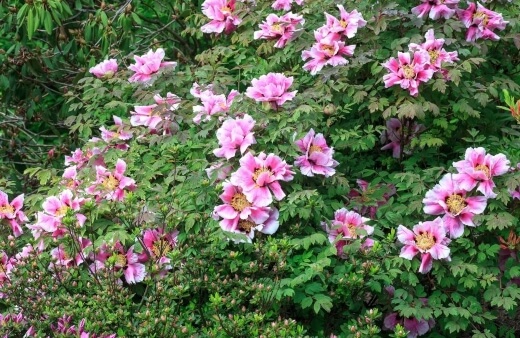
Tree peony cuttings are insanely simple to take, but also very susceptible to failing through exhaustion. There are a few ways around this, but the simplest is to ensure they are kept somewhere cool and bright, with extra humidity once leaves form.
Method 1:
- Tree peonies grow best from semi-ripe cuttings taken in early autumn when flowering has finished, and new terminal buds are starting to show at old leaf nodes.
- Cut around 15cm from this year’s growth, just above a node to promote new growth next year.
- Trim the cutting by removing all leaves, but not the buds.
- Cut below the lowest node at an angle, then above the next node at 90 degrees to mark the top. Do this along the cutting for as many sections as you can.
- Pot the cuttings into a gritty compost mix and cover with a plastic bag.
- Leave them somewhere moist, cool, and bright through winter, and don’t let them dry out.
- In spring, you should have new growth forming from the terminal nodes you left in place.
- Continue to grow these for 1-2 years until they are strong enough to plant in the garden.
The more complicated, but more reliable method is grafting, which requires rootstock, and a tip cutting. The rootstock acts as a battery, packed with goodness, and all the strength to send water up into fresh cuttings.
Unusually, tree peony grafts will replace the rootstock after a few years with the roots of the top growth, meaning you get a truer representation of the original plant.
Tools:
- Semi-mature root from a herbaceous peony
- Scions (semi-mature tip cuttings) from a tree peony
- Sterilised secateurs for ALL cuts
Method 2:
- Pick and clean a 6” section of root from a herbaceous peony, and leave it to callous slightly overnight.
- Cut a 6” section from the top growth of a tree peony. Ensure there is a terminal bud on each section (a potential new shoot for next year, between a leaf and the branch).
- Cut above the top terminal node at 90 degrees, and below the next node down on a 45-degree angle.
- Make a 45-degree cut at the top of the rootstock (it HAS to be the top as water will only flow in the direction it was in the ground).
- Connect the 45-degree cut of rootstock to the matching cut on the cutting (the aim is to match up the cambium layers which are packed with hormones, and pass water/nutrients into xylem and phloem cells).
- Wind and tie elastic bands around the connection to secure it, then wrap it in grafting tape.
- Plant the grafted cutting into garden soil so the tip is just showing.
- Water if the soil dries out and by early spring new growth should start to appear.
- Grow your cuttings on for another year. You can make dozens of plants this way, so it’s worth the effort.
Propagating Herbaceous Peonies from Cuttings
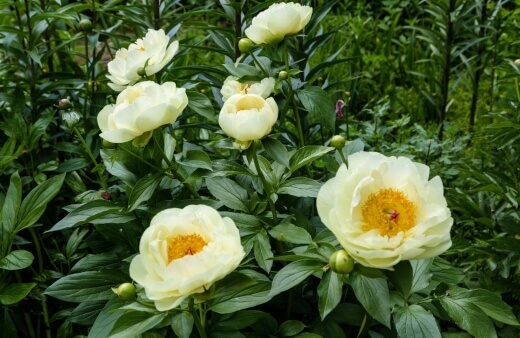
Herbaceous peonies grow from small markers on the roots called ‘eyes’, similar to potatoes. Taking herbaceous peony cuttings is best done in spring when new growth is around 10-15cm tall, and the leaves haven’t fully unfurled.
Tools
- Clean sharp cutting knife or secateurs
(Find the best secateurs you can easily get online here). - Gritty compost or a 50:50 mix of perlite and compost
- 8cm plastic pots
Method
- Cut right at the base of a fresh shoot, taking a small section of root with it (a few millimetres is enough to provide the right growth hormones).
- Quickly pot your cutting into a free-draining compost mix in a small plastic pot.
- To save space, pot one cutting in each corner of the pot (planting against the plastic helps to improve drainage and gives a straighter run for young roots).
- Water the pots thoroughly, then cover them with a clear polythene bag, or grow them on in a cold frame to maintain humidity.
- Check on them regularly, as basal cuttings from herbaceous plants can take in as little as 1 month, and will need potting on later in summer.
- They can be planted out next spring.
Intersectional Peonies Propagation from Cuttings
You can take intersectional peony cuttings just like tree peonies, with terminal bud cuttings in autumn. However, their flexible stems and herbaceous tendencies make them ideal candidates for layering.
This is by far the simplest way to root any peony and create new peony flowers and requires nothing more than a bit of wire.
Tools:
- Utility knife
- Garden wire
Method:
- Pull flexible shoots from the outside edge of your intersectional peony down to ground level.
- Just below a node, make a small v-shaped incision in the bark.
- Make a simple peg from garden wire, and pin the cut node to the soil around your peony.
- Leave the stem attached, and wait until next year, when it should have rooted, and will have its own roots and stems growing from the pinned point.
- Cut the layered cutting away from the original plant, and pot it into a gritty compost mix until it's ready to plant elsewhere.
Propagate Herbaceous and Intersectional Peonies from Division
There are plenty of guides online about dividing herbaceous and intersectional peonies, but they make it seem much harder than it is. While you can dig up the entire root, and look for thin points, it’s really not necessary.
In autumn, as the top growth starts to die back, look for hollow sections of the plant. This is where the root is weaker, and there will be eyes ready to send up new shoots around the outside of the plant.
Ideally, you want two or three eyes to provide a good-looking plant next year, but even without them, they can be pruned into bushier shapes and will bush out over time anyway.
Method:
- Find a hollow-looking section of a peony, where stems aren’t emerging or can be easily split
- Dig down firmly and sharply with a shape and lift half the plant
- Replant the divided section quickly to stop it from drying out
- If dividing in autumn, plant the new section in a container and store it in a cold frame
- If dividing in spring, plant directly in the ground
How to Propagate Peonies from Seeds
All peonies grow the same way from seed, with gritty compost, and bright warm days in spring. They like a period of cold before they germinate, so for warmer regions, store seed in the fridge in an air-tight bag for 2-3 weeks before planting.
After cooling your seeds, simply plant them into a gritty compost and water them well. Germination can take up to four weeks, and they are slow to develop, but with patience, you’ll have peonies for a fraction of the price you’d pay in garden centres.
Note: Tree peony seeds will need soaking, and/or sanding slightly to soften their shells before planting.
How to Prune Peonies

Pruning Tree Peonies
Tree peonies need deadheading like most flowering plants, and will continue blooming for an extra few weeks if blooms are removed when they begin to fade.
This is a simple reaction by the plant as it will continue trying to produce seeds until its flowering season is at an end.
Aside from deadheading, there are some essential tips for pruning tree peonies that don’t apply to other forms:
- Remove dead, damaged, or diseased growth to reduce cross-infection and improve the appearance of the plant at any time of year.
- In spring, cut back 1/3 of the plant to the ground, just above a fresh bud. This encourages lower, more even flowering in summer.
- In spring or early summer, cut unwanted branches right to the ground, below any buds or nodes to prevent them from regrowing. This helps to permanently improve the shape of the plant.
- In early spring, cut any taller stems back by about three buds to encourage a bushier shape.
How to Prune Herbaceous Peonies
Herbaceous peonies need virtually no pruning, other than very regularly deadheading in summer. They are vigorous bloomers and their highflyer scented flowers should be extended for as long as possible.
When deadheading, cut back to the next leaf node to encourage re-flowering, rather than just below the flower, which leaves unsightly bare stems.
Pruning Intersectional Peonies
Intersectional hybrids can be pruned in several ways. Their stems will live through winter and will flower above the height of whatever growth is left in spring, but their herbaceous top growth should be routinely trimmed back to the woody bases, just above a node.
Alternatively, you can cut right back to ground level for a lower flowering plant in summer, but with more vigorous growth and a slightly longer season.
Common Peony Pests in Australia
Aphids
Aphids can be a problem for all three types of peonies. They love the tender young shoots that emerge in spring and can cover plants in a sweet secretion called honeydew which encourages funguses and bacteria to develop along the stem. This can prevent buds from opening, and kill off the top growth.
Spray plants with organic insecticides like neem oil or horticultural soap to reduce the problem, or introduce predators like ladybugs.
Ants
Ants are particularly frustrating pests on peonies as they will actively farm aphids by bringing them onto the young shoots or tree, herbaceous and intersectional plants in order to access their sweet secretions called honeydew.
Ants will also eat into the unopened flower buds and can cause fungal problems that prevent peony flowers from opening at all. Release ladybugs into the garden, or wasps that will outcompete the ants by eating the aphids.
Slugs
Slugs love the young shoots of herbaceous peonies and can be a big problem. Lay lightly crushed egg shells around the base of your prized peonies in early spring as shoots emerge to discourage them, or bury a plastic cup filled with beer into the soil nearby.
The slugs will be unable to resist and simply drown themselves.
Root-knot nematodes
Root-knot nematodes are frustrating and very hard to prevent. If you plan on planting peonies into a bed that was previously laid to lawn, consider adding beneficial nematodes that attack damaging nematodes, or leave the soil bare for a year before planting.
Beetles
Beetles of all types eat into the buds of peonies before they flower in summer to gain access to the rich carbohydrates and sugars. Spraying garlic onto the buds can help to confuse and deter them, but the most effective control is to head into the garden in the morning and pick them off one by one.
Bees
Bees are not a garden pest and should never be treated as one, but if you grow double peonies or bombe peonies, there are several species of bee that will cut through the base of peony flowers to access nectar as they can’t access from the top without getting trapped.
This is just the price you pay for beautiful peony flowers, and sadly there isn’t much you can do about it without damaging wildlife.
Peony Diseases to Look Out For
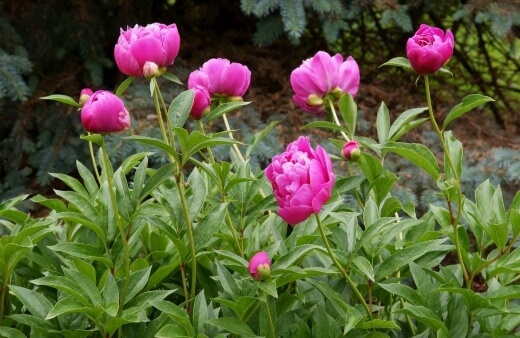
The majority of peony diseases are limited to herbaceous and intersectional peonies, but tree peonies are not immune to them. Their woody stems do however make them less likely to suffer from southern blight, crown call, and botrytis blight.
Bacterial blight
Yellow or reddish rings surrounding dark brown spots are caused by a bacterial pathogen called Xanthomonas, which is carried by insects and dirty tools between plants.
It can be reduced by proper air circulation and keeping the foliage dry by watering at the roots, rather than spray irrigation. Remove any signs of blight as they occur to prevent spread.
Botrytis blight
Botrytis blight affects almost all garden plants but can be avoided by reducing spray irrigation and humidity. It is a fungal infection that thrives in warm humid conditions and can make growing peonies near irrigated lawns quite difficult.
Remove any brown buds or foliage and consider an organic fungicidal treatment.
Phytophthora blight
Unlike other blights, which cause mould or damp lesions, Phytophthora blight produces a leathery brown texture on leaves and new shoots which will die off.
If left untreated it will spread and cause damp rot in the centre of the plant, so any leathery brown material should be removed and ideally burned.
Southern blight
Southern blight occurs on herbaceous and intersectional peonies when wet weather follows prolonged drought. The struggling plant will have tiny cracks along its weakened stem, which is then splashed by the soil from the rain, or heavy watering, allowing fungal infection to set in.
To prevent southern blight, grow peonies in well-drained soil, water them evenly and regularly, and remove the lowest leaves.
Powdery mildew
Powdery mildew is rarely a problem for peonies in Australia, but spray irrigation paired with warm weather can create the right conditions for this white, mouldy covering that spreads across every part of the plant.
Powdery mildew rarely kills plants, but can live in the soil for years and will limit flowering. Apply a general fungicide to the foliage after early signs to reduce spread.
Root rot
Overwatered plants will have damp soil at their base but the wilting foliage of a plant that appears to be suffering from drought. This is caused by rotten roots that no longer send water up to the plant’s leaves or buds.
All types of peonies, thanks to their thick roots, are quite simple to treat for root rot. Simply dig the plant out of the ground, and cut back most of the top growth to reduce strain on the roots.
Then wash and cut away any black, smelly, or soft roots before leaving them to callous for 24 hours. After that, just repot the plant into clean compost for a few months until new growth appears.
Peonies Frequently Asked Questions
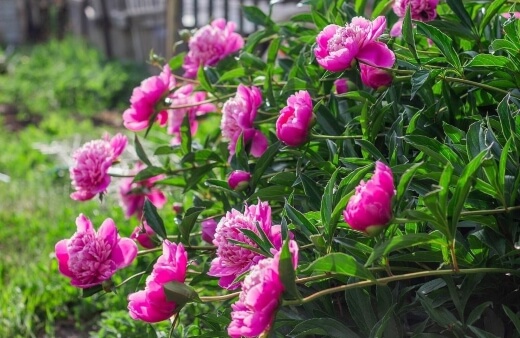
Do peonies multiply?
Herbaceous peonies grow from a thick fleshy root and produce new shoots from the eyes along the root. They do not strictly multiply as the roots do not separate naturally into new plants, but they will spread slowly to form larger plants which can be easily divided in spring.
What happens if you don’t cut back peonies?
If you don’t cut back peonies in autumn or spring they will become leggy and leave large hollow sections around their base. In cooler or wet climates, intersectional peonies can rot over winter, so should be cut back to woody growth to protect them.
How long do peony flowers last?
Individual peony flowers can last for around ten days but are best deadheaded after seven as soon as they start to fade. The sooner you deadhead spent blooms, the sooner your plants can start producing a second flush.
While peony flowers generally bloom for around six weeks, this can easily be extended to eight with regular deadheading.
How many years do peonies last?
Some species of tree peonies are known to live for over 100 years, but the average is more like 80. Either way, they are a good investment for any garden, and will more than likely outlive you and keep flowering well into the later life of your children.
Enjoy Stunning Blooms by Growing Peonies in Your Garden
With sweetly scented blooms, intuitive care, and a lifespan that outlives most humans, peonies are one of the best investments for any garden.
Despite the challenges of growing them in Eastern Australia, they are still worth trying, because if you can find a place to grow peonies, they will continue growing for decades with stunning blooms when you need them most.
Now you know how to grow peonies, the only question is choosing the right one. If you’re willing to splash out, surely intersectional are worth a go, but for me, it’s the simplicity of highly scented, single-form tree peonies that gets my heart racing.
Published on August 30, 2022 by Maisie Blevins
Last Updated on February 22, 2024




